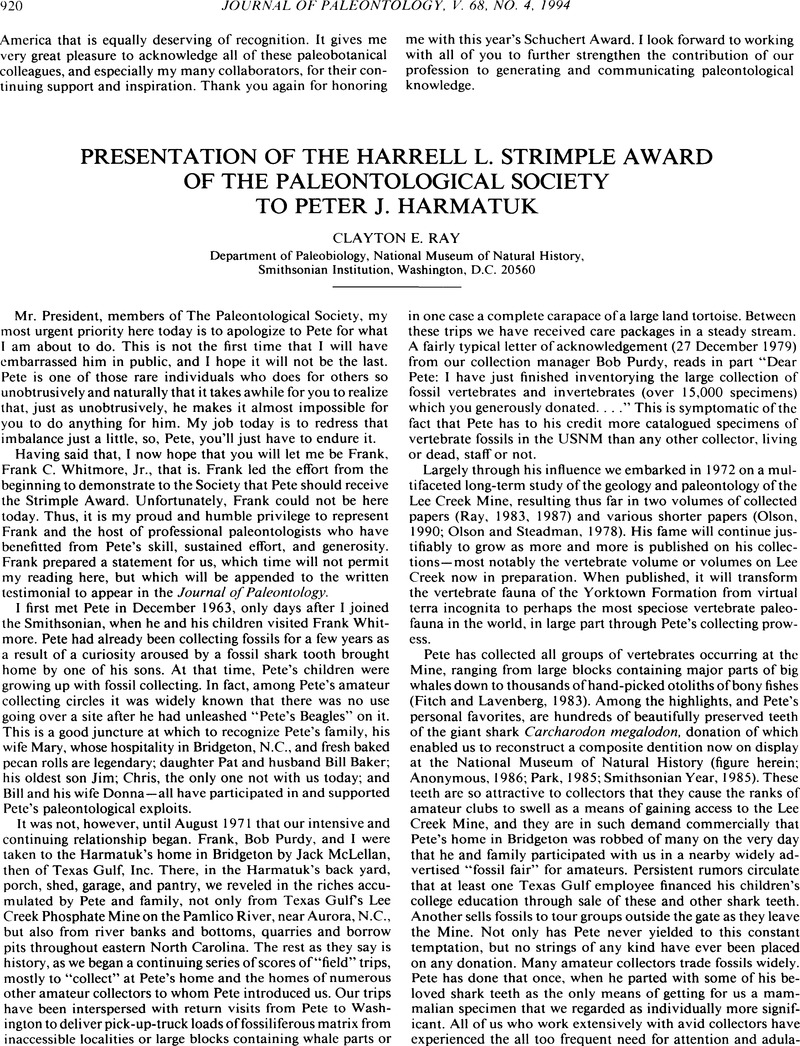No CrossRef data available.
Article contents
Presentation of the Harrell L. Strimple Award of The Paleontological Society to Peter J. Harmatuk
Published online by Cambridge University Press: 14 July 2015
Abstract
An abstract is not available for this content so a preview has been provided. Please use the Get access link above for information on how to access this content.

- Type
- Society Records and Activities
- Information
- Copyright
- Copyright © The Paleontological Society
References
Publications Based in whole or Significant Part on the Work of Peter J. Harmatuk
Bailey, R. H.
1976.
Eutrephoceras (Nautiloidea) from the Paleocene Beaufort Formation of North Carolina. Tulane Studies in Geology and Paleontology, 12(4):235–242.Google Scholar
Cooper, G. A.
1988. Some Tertiary brachiopods of the east coast of the United States. Smithsonian Contributions to Paleobiology, 64:1–45.Google Scholar
Domning, D. P., Morgan, G. S., and Ray, C. E.
1982. North American Eocene sea cows (Mammalia: Sirenia). Smithsonian Contributions to Paleobiology, 52:1–69.CrossRefGoogle Scholar
Fitch, J. E., and Lavenberg, R. J.
1983. Teleost fish otoliths from Lee Creek Mine, Aurora, North Carolina (Yorktown Formation: Pliocene). Smithsonian Contributions to Paleobiology, 53:509–529.CrossRefGoogle Scholar
Furnish, W. M., and Glenister, B. F.
1987. Miocene cephalopods from North Carolina. Smithsonian Contributions to Paleobiology, 61:9–11.Google Scholar
Hueber, F. M.
1983. Fossil woods and resin-like substances from the Lee Creek Mine. Smithsonian Contributions to Paleobiology, 53:269–285.Google Scholar
Hueber, F. M., and Watson, J.
1988. The unusual Upper Cretaceous conifer Androvettia from eastern U.S.A.
Botanical Journal of the Linnean Society, 98:117–133.Google Scholar
Kier, P. M.
1980. The echinoids of the Middle Eocene Warley Hill Formation, Santee Limestone, and Castle Hayne Limestone of North and South Carolina. Smithsonian Contributions to Paleobiology, 39:1–102.Google Scholar
Kier, P. M.
1983. Upper Cenozoic echinoids from the Lee Creek Mine. Smithsonian Contributions to Paleobiology, 53:499–507.Google Scholar
Olson, S. L.
1990. Stomach contents of the extinct Alcidae genus Australca sp., p. 196–198. In
Boucot, A. J., Evolutionary Paleobiology of Behavior and Coevolution. Elsevier, Amsterdam.Google Scholar
Olson, S. L., and Steadman, D. W.
1978. The fossil record of the Glareolidae and Haematopodidae (Aves: Charadriiformes). Proceedings of the Biological Society of Washington, 91(4):972–981.Google Scholar
Ray, C. E. (Ed.). 1983. Geology and paleontology of the Lee Creek Mine, North Carolina, 1. Smithsonian Contributions to Paleobiology, 53:1–529.Google Scholar
Ray, C. E. (Ed.). 1987. Geology and paleontology of the Lee Creek Mine, North Carolina, II. Smithsonian Contributions to Paleobiology, 61:1–283.Google Scholar
Ray, C. E., Anderson, E., and Webb, S. D.
1981. The Blancan carnivore Trigonictis (Mammalia: Mustelidae) in the eastern United States. Brimleyana, 5:1–36.Google Scholar
Ray, C. E., and Sanders, A. E.
1984. Pleistocene tapirs in the eastern United States. Carnegie Museum of Natural History Special Publication, 8:283–315.Google Scholar
Year, Smithsonian, 1984. 1985. Annual Report of the Smithsonian Institution for the year ended September 39, 1984:91–93.Google Scholar




